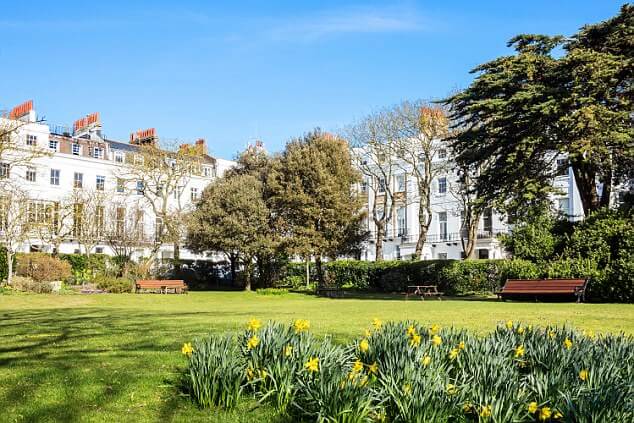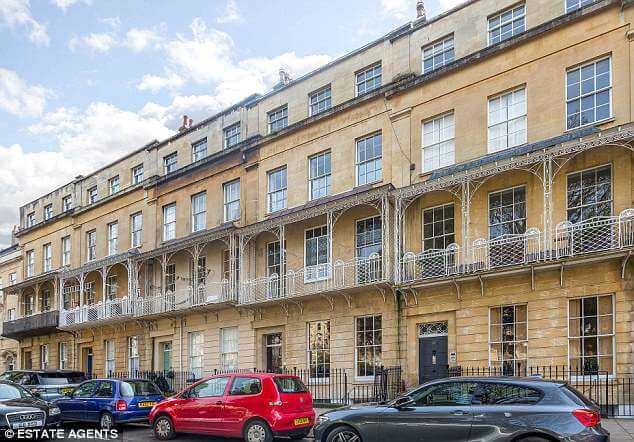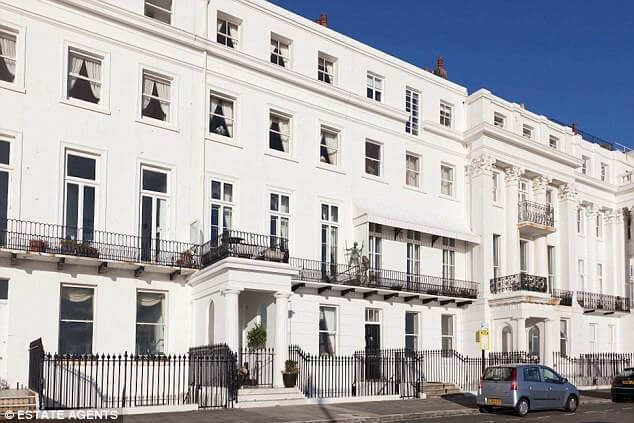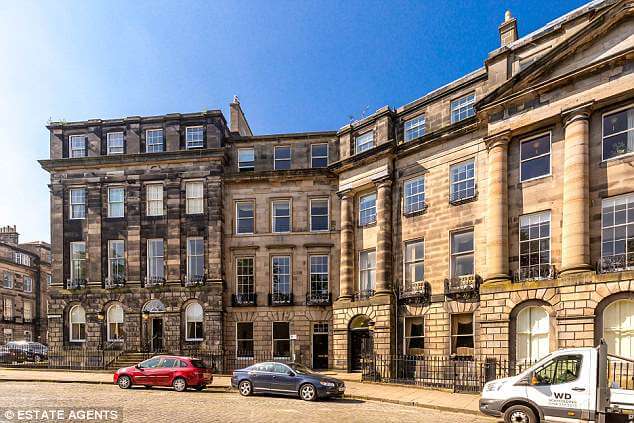By Laura Parnaby
Americans are flocking to the ‘Hamptons of England’, where the cost of buying a charming countryside property is 40 percent cheaper than purchasing stateside.
Nestled within a range of rolling hills which rise from the lush meadows of the upper River Thames to the cliffs beside the Severn Valley, the Cotswolds is a picturesque holiday destination located a scenic 90-minute train ride from London.
‘It’s terribly beautiful. The scenery is glorious,’ said local store owner and Boston native Jesse D’Ambrosi, who moved to the area five years ago.
Home to 91,000 people, the Cotswolds, which straddles six southern English counties and is governed from Gloucestershire, comprises the largest swathe of protected natural beauty in the United Kingdom.
Punctuated by quirky local businesses and honey-colored limestone cottages, its stunning green pastures have long presented an attractive escape from the capital for those wealthy enough to afford a second home.
In recent years, it’s also seen a boom in popularity from American expats, who bring a host of new demands to the area while embracing quintessential English country life.
Cotswolds Council leader Joe Harris said Yankees are now ‘all over’ the area. ‘We have an American member on our council,’ he told the Daily Mail. ‘Most people in our area know an American or have an American neighbor.’
This is reflected in the footfall at D’Ambrosi’s Fine Foods store, which sells classic American snacks it’s hard to find anywhere else in the UK.
The colorful eatery attracts a hefty 50 customers each day on average, despite being located in the market town of Stow-on-the-Wold, which sits atop an 800-foot hill.
‘As a joke I would get in some American products and put them in the window. I was shocked at how much of that product I moved,’ D’Ambrosi told the Daily Mail.
The store offers luxury Thanksgiving and Fourth of July hampers, as well as classic American snacks like bright orange Goldfish crackers and crimson jars of Lawry’s Seasoned Salt.
D’Ambrosi enjoys life in a cozy cottage with her seven-year-old daughter Rose, after previously living in Amsterdam, Paris and New York City, with her now ex-husband.
The local entrepreneur said the easy commute to London from the British country escape makes it comparable to the ritzy Long Island beaches which are a stone’s throw from Manhattan.
‘The Cotswolds is the Hamptons of England – without the sea of course,’ D’Ambrosi told the Daily Mail. ‘It’s also comparable to going upstate, though it’s a bit more rural and bucolic.’
Private members clubs have proliferated in the Cotswolds in recent years, reflecting this influx of a new kind of wealth akin to the Hamptons elite – as opposed to the traditional agricultural landowning families who have lived in the area for centuries.
English real estate experts Camilla Dell and Harry Gladwin told the Daily Mail that Americans have increasingly been looking to the UK for home purchases over the past half-decade.
‘Americans are a significant buying force for UK property,’ said Dell, the founder of Black Brick property consulting firm, where 25 percent of clients are from the US, bringing an average budget of $1million to $10million for a second home.
Dell, who herself has a holiday home in the Cotswolds, said Americans started flocking to the UK in greater numbers ‘five to six years ago’, when the dollar was comparatively strong against the pound in the aftermath of Brexit.
‘We started to see a significant uptick in American inquiries at that point,’ Dell said.
‘Since 2014, the London real estate market hasn’t really gone anywhere,’ she added.
Dell said the combination of this property market plateau, relatively higher wages in the US, and the dollar strengthening against the pound means Americans purchase homes ‘at almost a 40 percent discount’ compared with in 2014.
She added that the UK government’s abolition of non-domiciled tax status is also a draw for wealthy Americans.
Gladwin, who runs the Cotswolds division of property consulting firm The Buying Solution, said affluent American expats coming to the UK are honing in on his region in particular.
‘We’ve definitely seen a noticeable rise in interest from American buyers in the Cotswolds over the past few years,’ he said.
‘Americans are drawn by the area’s natural beauty, historic charm and strong sense of community, often built around wonderful village pubs – it’s a perfect slice of English country life.
‘Many are looking for a second home or a lifestyle shift and the appeal of achingly beautiful Cotswold stone houses, privacy and space continues to resonate strongly.’
‘When Americans think of the quintessential British countryside, the Cotswolds comes to mind,’ Dell agreed.
She said Americans love the chocolate-box cottages built with local Jurassic limestone which make every village look like a scene from The Holiday.
Dell said popular destinations include the ‘golden triangle’ of villages which are most easily accessible from London – comprising D’Ambrosi’s hometown of Stow-on-the-Wold, along with Chipping Norton and Burford.
Maryland native Sarah Kirk, 43, is among the American expat community who relocated to the ‘golden triangle’, partly because her husband is from the area.
The homemaker, who has four children aged between two and nine, shares a glimpse of her fairytale life in the Cotswolds each day with her 31,000 Instagram followers.
She said she loves ‘the slower pace of life, emphasis on seasonal living, beautiful landscapes to explore, and conservative small-town values’.
Kirk spoke with the Daily Mail over the phone from her sprawling backyard – or back garden in British – as birds could be heard chirping in the background.
‘It’s just a really beautiful part of the country where people go to look for that country living feel,’ she said.
‘My children have a lot of free rein here, a lot of places to wander. It’s a slow childhood,’ said Kirk, who previously lived in rural Virginia and South Carolina, as well as New York City and Washington DC.
‘There’s space here, not only physically but mentally, for a lot of peace. We are sheltered from some of the bigger issues that you might have in city life.’
Kirk said she has noticed the boom in private members clubs, usually frequented by Londoners she refers to as ‘the white trainers (sneakers) crowd’, who come up to the Cotswolds for a weekend retreat, which has given pockets of the area a ‘Hamptons-like’ feel.
Relatively new Cotswolds clubs include The Lakes by Yoo spa which is partnered with British supermodel Kate Moss, and Estelle Manor in Eynsham Park.
The quintessentially English Aynhoe Park was recently bought up by American furnishings company Restoration Hardware (RH), and it now sells the US-made fittings.
Dell said RH hosted an opening party at the stately home in 2023, which drew in a star-studded crowd featuring the likes of Sydney Sweeney, Zoe Saldaña, Regé-Jean Page, Ellen DeGeneres, Portia de Rossi, and supermodel Jourdan Dunn.
Local councilor Sandra Smith, who moved to the beauty spot in 1987 from Seattle, Washington, said that despite the celebrity buzz surrounding both the Hamptons and the Cotswolds, the latter is much more inclusive.
‘The Hamptons is all set up for really rich people with rich people things. It’s not like that here at all,’ the 59-year-old told the Daily Mail.
‘It can be upper class if you want it to be, but you can do it cheaply as well.’
‘There are a lot of local businesses that are really quite quaint. It’s not all Jeremy Clarkson,’ she added, referring to the Top Gear host’s Diddly Squat Farm shop.
‘There’s a big arts culture out here. It’s a little bit bohemian.’
Smith, who lives in the ‘Cotswolds capital’ of Cirencester, said she only planned on moving to the area for two years back in the eighties, but she fell in love with the ‘tiny houses and cars’ and ‘sense of community’.
‘I just really like living in Britain,’ she said. ‘The American middle-class lifestyle is a big house and a big car – but it’s a bit soulless.
‘You spend a lot of time driving around to shopping malls in the US and everything is so far apart. I love how you can do anything on foot around here.
‘Plus, my friends from America are always talking about gun crimes and shootings. Nothing like that happens here. It’s wonderfully boring and stable.’
Smith asked the Daily Mail to use a pseudonym to protect her identity due to concerns about traveling as a naturalized Brit under Donald Trump’s administration.
She said she gave up her American citizenship decades ago in exchange for a British passport.
Black Brick founder Dell added that ‘political reasons’ have ‘certainly’ been driving American buyers to the Cotswolds more recently as people are keen to escape Trump’s hardline policies on issues like immigration, and college arts and sciences funding.
Liberal Democrat council leader Harris agreed that ‘many’ recent expats he has spoken with ‘are trying to get away from the political reality in America’.
‘We like having our American cousins here, they are very welcome,’ he added. ‘There’s a strong community here.’
The Daily Mail revealed in March that the number of Americans seeking UK citizenship had reached record levels since Trump was elected for a second term.
More than 6,100 US citizens applied last year, an all-time high after figures began two decades ago and 26 per cent more than in 2023.
US clicks on British job listings were also up 2.4 percentage points year on year to 8.5 percent, the sharpest increase from any country, according to job search site Indeed.
Immigration lawyers have said Trump’s presidential bid and victory in early November helped spur the increase in American movers, with others adding the US political landscape was ‘a very serious driver’.
This was epitomized by Ellen DeGeneres, when she stormed out of Hollywood following the presidential election in November and embraced a fresh start in a £15million ($20million) Cotswolds farmhouse.
The 67-year-old former talk show host moved across the pond with her celebrity wife Portia De Rossi, 52, but it wasn’t plain sailing. Their new home was surrounded by floodwater, prompting them to move to a new mansion around the corner.
Gladwin said celebrities are commonly drawn to the area because it ‘offers a discreet haven for high-profile individuals’.
‘With its low-key villages, excellent pubs and growing number of exclusive private members’ clubs like Soho Farmhouse, Estelle Manor and The Club by Bamford, it’s become a fashionable escape for celebrities and creatives,’ he told the Daily Mail.
‘They appreciate the balance of luxury and informality, all within reach of London and with great connections to the US.’
Ron Burkle is one of the ordinarily low-profile American real estate magnates who is eyeing the Cotswolds for his next project, called the Serpentine Lodge.
However, he spoke with the Daily Mail after he came up against unprecedented opposition from locals who railed against what they called his plans to construct a ‘McMansion’ amid their cozy cottage cul-de-sac.
Burkle said he wanted to work with local people to make sure everyone was happy with his scheme – though it might take a lot of negotiation.
The area is also home to former British Prime Minister David Cameron, or Lord Cameron of Chipping Norton, David and Victoria Beckham, X-Factor judge Simon Cowell and the Bamfords.
Though celebrities and high-flying businessmen occasionally threaten the natural harmony of the area, Smith, who works in town planning, added that the Cotswolds’ unique charm stems from its status as a protected area of natural beauty since 1966.
She said it’s the most perfectly-preserved pocket of traditional English countryside.
‘Much of the Cotswolds is a conservation area, which means developers can’t change much,’ she told the Daily Mail.
‘This is how it retains its character – it’s always going to be this way.’



